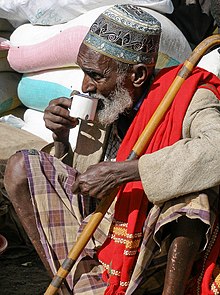
An izaar, also izar or ʾizār (Arabic: إِزَار),[1] also known as ṣārūn (صارون), futah (فُوطَة),[2] maʿawaz (مَعَوَز),[3] wizar (وِزَار),[4][5] maqtab (مَقْطَب)[6][7] is a traditional lower garment that is frequently used by men in Oman, Somalia, United Arab Emirates and Yemen. Izaars are commonly used in Yemen, it is commonly referred to as maʿawaz (مَعَوَز) and the Hadhrami people call it ṣārūn (صارون) in their local dialect. It is also used by some in Iraq, Kuwait, Bahrain, Saudi Arabia and Qatar, and the Horn of Africa (Djibouti, Ethiopia and Eritrea). A white izaar is typically worn underneath thawbs in Oman and the UAE instead of sirwar pyjamas. Izzars are similar to lungis and sarongs, worn in India, Indonesia, Malaysia, Bangladesh, Pakistan and countries in some parts of East Africa.
Izzars are commonly worn by Yemenis at home, and work.[8] It is also worn in the city of Aqaba. Some of these may feature tassels.
The izaar may be considered synonymous with the lungi in the Indian subcontinent and with the macawiis (معويس) in the Horn of Africa. It may also be considered a type of sarong (spelt saroun صارون in Arabic).